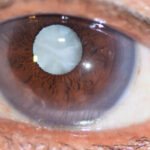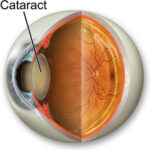CHOOSING THE RIGHT IOL: TYPES OF INTRAOCULAR LENSES AND SELECTION CRITERIA
If you’re preparing for cataract surgery or refractive lens exchange, one of the most important decisions you’ll make is choosing the right intraocular lens (IOL). With several types available, each offering different benefits, it can be overwhelming to decide which one is best for your
vision needs.
What Is an Intraocular Lens (IOL)?
An intraocular lens (IOL) is an artificial lens implanted in the eye to replace the natural lens, usually during cataract surgery. Cataracts cause the eye’s natural lens to become cloudy, leading to blurred vision. By removing the cloudy lens and replacing it with an IOL, clear vision
can be restored. IOLs can also be used in refractive lens exchange, a procedure similar to cataract surgery but
performed to correct severe nearsightedness, farsightedness, or presbyopia.
Types of Intraocular Lenses (IOLs):
There are several types of IOLs available, each designed to address different vision needs. The main categories include:
1. Monofocal IOLs.
2. Multifocal IOLs.
3. Extended Depth of Focus (EDOF) IOLs.
4. Toric IOLs (for astigmatism).
5. Accommodating IOLs.
1. Monofocal IOLs:
What They Do
Monofocal IOLs are the most common type of lens used in cataract surgery. They provide clear
vision at one fixed distance—either near, intermediate, or far. Most people choose
distance vision and rely on glasses for reading or close-up tasks.
➡️ Pros:
✔ Excellent clarity for one distance.
✔ Covered by most insurance plans.
✔ Fewer visual disturbances compared to premium lenses.
➡️ Cons:
✖ Requires glasses for near or intermediate vision.
✖ Does not correct astigmatism.
Best For:
– Patients who don’t mind wearing glasses for near tasks.
– Those prioritizing crisp distance vision.
2. Multifocal IOLs:
What They Do:
Multifocal IOLs (like bifocal or trifocal glasses) provide clear vision at multiple distances (near,
intermediate, and far). They use different lens zones to focus light, reducing dependence on
glasses.
➡️ Pros:
✔ Reduces or eliminates the need for glasses for most activities.
✔ Good for patients with presbyopia.
➡️ Cons:
✖ May cause halos or glare around lights at night.
✖ Slightly reduced contrast sensitivity compared to monofocal lenses.
✖ Not ideal for those with very high astigmatism or certain eye conditions.
Best For:
– People who want to minimize dependence on glasses.
– Those willing to adapt to potential visual side effects.
3. Extended Depth of Focus (EDOF) IOLs.
What They Do:
EDOF lenses provide a continuous range of vision from intermediate to far distances, with some
near vision capability. They work by elongating the focus point rather than splitting light like
multifocals.
➡️ Pros:
✔ Smooth transition between distances.
✔ Fewer halos and glare compared to multifocal lenses.
➡️ Cons:
✖ May still require reading glasses for very small print.
✖ Not as strong for near vision as multifocals.
Best For:
– Patients who prioritize seamless mid-to-far vision.
– Those who want reduced glare compared to multifocals.
4. Toric IOLs.
What They Do:
Toric IOLs correct astigmatism, a condition where the cornea is irregularly shaped, causing blurred or distorted vision. These lenses have different powers in different meridians to
compensate for the uneven curvature.
➡️ Pros:
✔ Corrects astigmatism, reducing dependence on glasses.
✔ Available in monofocal, multifocal, and EDOF versions.
➡️ Cons:
✖ Requires precise alignment during surgery.
✖ More expensive than standard monofocal IOLs.
Best For:
– Patients with significant astigmatism.
– Those who want clearer vision without relying on glasses or contact lenses.
5. Accommodating IOLs:
What They Do:
Accommodating IOLs are designed to move or flex inside the eye, mimicking the natural lens’s ability to shift focus between near and far distances.
➡️ Pros:
✔ Provides a more natural range of vision.
✔ Fewer visual side effects compared to multifocals.
➡️ Cons:
✖ May not provide as strong near vision as multifocals.
✖ Limited availability compared to other IOL types.
Best For:
– Patients who want a more natural focusing ability.
– Those who prefer a middle ground between monofocal and multifocal lenses.
Key Factors to Consider When Choosing an IOL:
Selecting the right IOL depends on several factors, including your lifestyle, eye health, and
personal preferences. Here’s what to discuss with your eye surgeon:
1. Your Visual Needs & Lifestyle.
– Do you prefer glasses-free vision? → Multifocal or EDOF lenses may be best.
– Do you drive a lot at night? → Monofocal or EDOF lenses may reduce glare.
– Do you work on a computer? → EDOF or multifocal lenses help with intermediate vision.
2. Eye Health & Pre-existing Conditions.
– Astigmatism? → Toric IOLs are necessary.
– Dry eye or macular issues? → Some premium lenses may not be suitable.
3. Budget & Insurance Coverage.
– Monofocal IOLs are usually covered by insurance.
– Premium lenses (multifocal, toric, EDOF) often involve extra costs.
4. Willingness to Adapt to Side Effects.
– Multifocal lenses may cause halos; monofocals require glasses.
– Discuss how different lenses might affect your night vision.
Final Thoughts:
Choosing the right IOL is a personalized decision based on your vision goals, eye health, and lifestyle. While premium lenses (like multifocal or toric IOLs) offer greater independence from glasses, they may come with trade-offs like glare or higher costs.
The best way to decide is to have a detailed discussion with your eye doctor, who can recommend the best option based on your eye measurements and daily activities.










